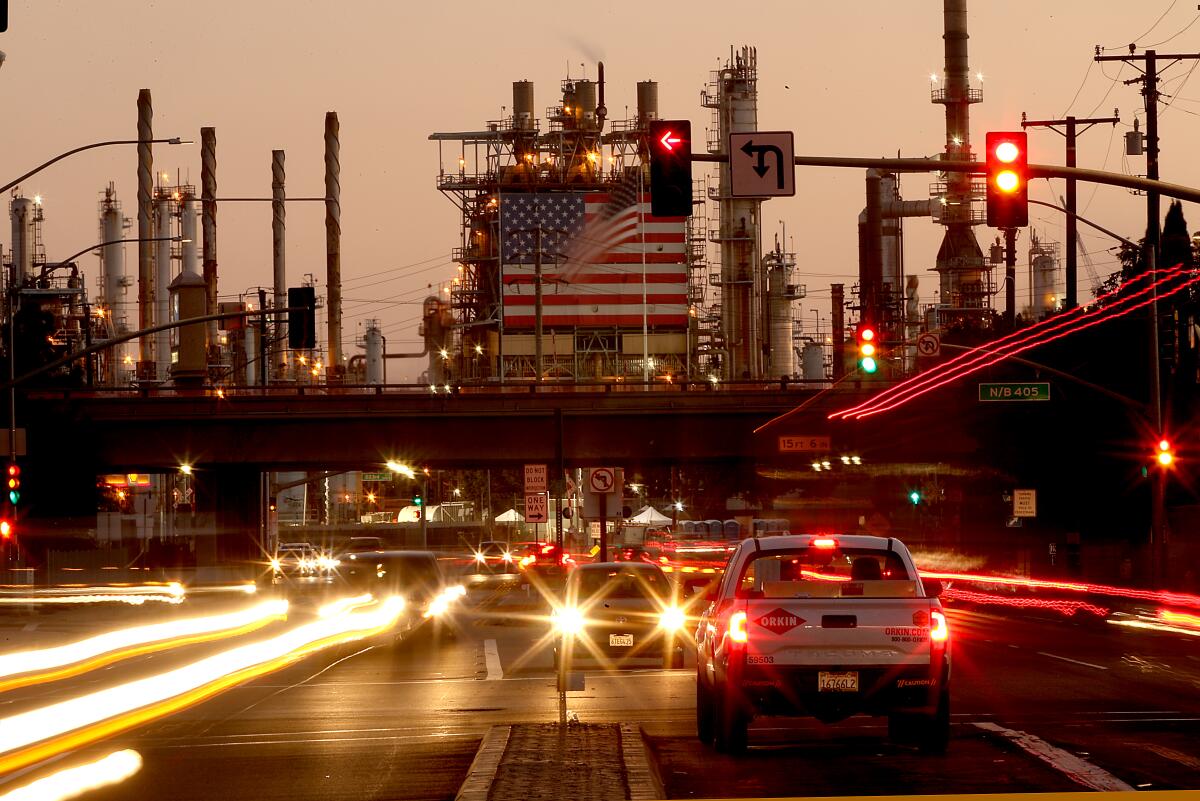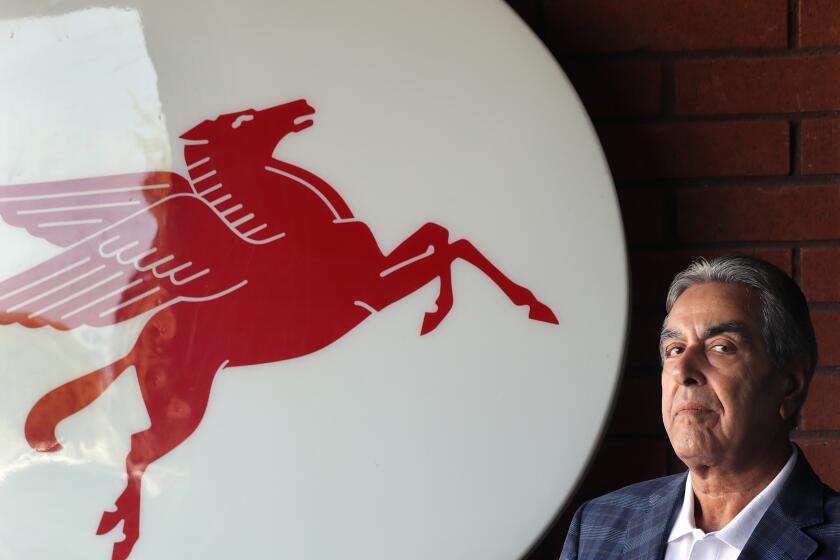Prepare for more gas price hikes. Here’s why—and who’s to blame

- Share via
As California energetically attempts to decarbonize the state’s economy, some in Sacramento fear the plan faces a looming threat: astronomical gas prices that could fuel a massive public backlash.
A state mandate will phase out sales of new internal combustion cars and light trucks by 2035. The retail price of gasoline is likely to rise as refineries and other industry players seek to maximize profit before demand for the product fades away.
The California Energy Commission is investigating the issue, and held an all-day hearing on the matter Nov. 29.
The stakes are high. “If we screw this up, whether it’s gasoline prices or an electrical load [from electric cars] that exceeds supply, it’s going to put a black eye on all of the energy transition,” UC Berkeley professor Severin Borenstein told the commission.
Borenstein, who has studied energy prices for decades, recalled the 2000-01 debacle in which California famously botched its aggressive attempt at electricity deregulation. Widespread blackouts caused economic disruption as companies such as Enron gamed the system to their financial advantage. The end result: The state backtracked on electricity deregulation.
Plenty of challenges lie ahead as California mandates zero-emission cars, including cost and access to charging.
Borenstein suggested that gasoline refiners, distributors and retailers may be playing market-shaping games, legal or otherwise, and that the state needs to investigate. It’s unclear whether California politicians will do so.
Meanwhile, on Monday Gov. Gavin Newsom unveiled his proposal to lawmakers to place a cap on oil refinery profits in California.
The state faces a delicate balance as it, in effect, dismantles the local gasoline refinery industry.
This year Californians will burn about 15 billion gallons of gasoline. The energy commission forecasts that will drop to 8 billion by 2030 and less than 2 billion by the 2040s.
But there will still be 16 million gasoline and diesel cars on the road in 2035, the state forecasts. No one’s sure how much drivers will be paying at the pump.
The issue was framed by Siva Gunda, the commission’s vice chair, when he kicked off the gas price hearing with an observation and an admission: “Many of us are going to drive gasoline cars for a very long time, including myself, who drove in a gasoline car this morning.”
His comments highlight an obvious reality: While high gas prices hurt the poor and the working class the most, all Californians — whatever their political stripe — dislike high gas prices. Research shows that expensive gasoline nudges some people to buy electric cars.
The ‘California premium’
The state’s gasoline prices have been at or near the top in the nation for decades. The basic reasons are well known. California’s gasoline taxes are higher, and the state requires special kinds of gasoline to reduce pollution. Plus, refiners pay additional costs in the carbon allowance market. The state’s isolation from most of the refining market, concentrated along the Gulf of Mexico, adds costs too.
Starting in 2015, as the state Legislature was crafting its tough greenhouse gas reduction rules, the so-called California premium on gas prices began to rise dramatically.
The price gap widened significantly that year after a major fire at an oil refinery in Torrance sent prices much higher. Prices remained high even after the refinery came back online.
Currently, according to AAA, average gas prices in California are about $5 a gallon compared with about $3.50 across all states. In late summer, as any California driver well knows, gasoline prices exceeded $6 — and in some places $8 — far higher than in other states.
The refining industry blames the high costs on expensive regulation. Oil industry critics, including Newsom, blame what they call windfall profits and price gouging.
There’s truth on both sides. The question is what to do about it.
Market prices or price gouging?
As electric vehicle mandates kick in between now and 2035, when the sale of new gas- or diesel-powered cars will be banned, demand for those fuels will shrink dramatically, cutting deep into refinery profits and eventually stranding their heavy industrial assets.
They have every incentive to keep profit margins as high as the marketplace and politics allow, to maximize returns on their investments before their business declines and eventually disappears. And business profits are not against the law.
The number of gas stations will also decline with demand, providing another opportunity to raise profit margins. Already, gas station owners are planning to exit the business and sell their real estate as the electric vehicle economy takes hold. Los Angeles and other California cities have banned construction of new gas stations, which further cuts supply.
A ban on sales of new gas-powered cars and light trucks is years off, but mom-and-pop gas station owners are already facing a dilemma: evolve for the EV era or sell out and move on?
In the face of those realities, two camps emerged from last week’s energy commission hearing: those who want to cap refinery profits and those who want more information to see whether antitrust or business fraud laws are being violated.
Jamie Court, president of Consumer Watchdog, called for a profit cap that he said would prevent price spikes like the ones motorists suffered this summer. He has an ally in Newsom.
While price gouging is a legal term that applies to price hikes specifically during a government-declared emergency, colloquially it’s become a term that translates into “unfairly expensive.” Newsom’s gouging penalty plan, which would be subject to debate and a vote in the Legislature, would penalize what he calls are excessive profits by the oil industry.
As for those at the hearing calling for more data from the industry, beyond notice of planned and unplanned refinery shutdowns, the nature of the information they sought was vague.
Asked by state Sen. Monique Limon (D-Santa Barbara) what kind of data would be helpful, California Energy Commission policy analyst Quentin Gee said the commission is “keeping a little more kind of on the general side at this point.”
Borenstein, however, offered an idea: He suggested a new government body with the authority to subpoena information to find out what’s happening in the “downstream” market, where gasoline is poured into trucks, delivered to underground tanks at gas stations, and then pumped into people’s vehicles.
He said his analysis shows that two-thirds of the California premium, above the state taxes and other well-known factors, comes from downstream, and more information would show whether the system is being gamed.
In fact, the state attorney general in 2020 filed business fraud charges against two major gasoline trading companies, accusing them of colluding to manipulate prices.
Borenstein made clear that he doesn’t know whether that’s happening, but he said it’s important that the downstream market become more transparent.
What about the refiners? Five companies control 97% of the state’s refining capacity — Chevron, Marathon, Valero, PBF and Phillips 66. All were invited to attend the hearing and all declined to do so.
Catherine Rehies-Boyd did attend. She runs the Western States Petroleum Assn., an industry group. She promised to work with the commission as it prepares its report on gasoline prices, which is due for completion in late 2024 — with plenty of hearings and opportunity for public participation planned between now and then.
More to Read
Inside the business of entertainment
The Wide Shot brings you news, analysis and insights on everything from streaming wars to production — and what it all means for the future.
You may occasionally receive promotional content from the Los Angeles Times.













